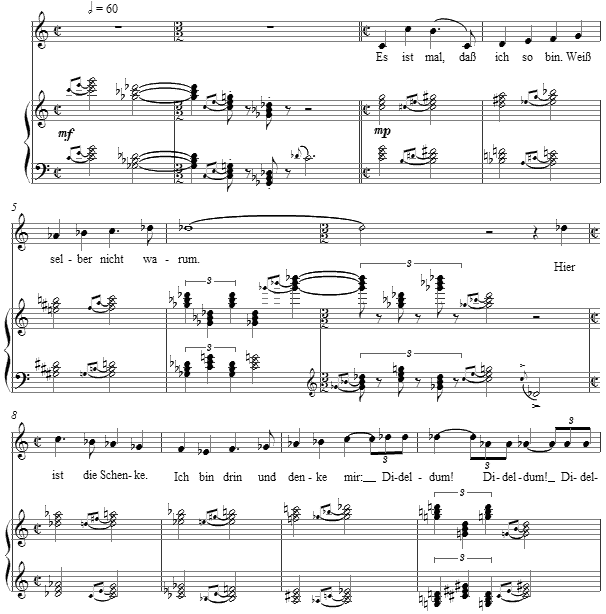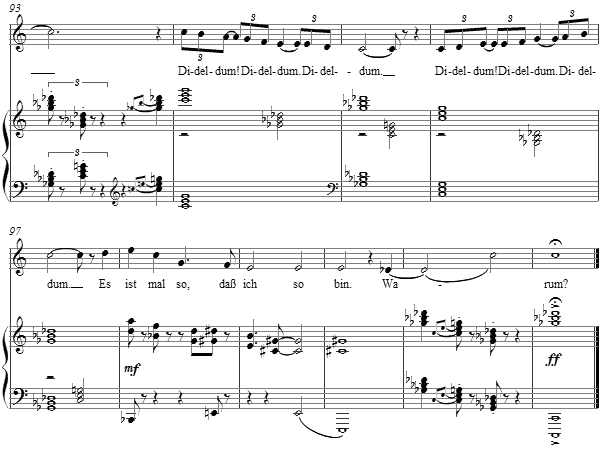Music and Texts of GARY BACHLUND
Vocal Music | Piano | Organ | Chamber Music | Orchestral | Articles and Commentary | Poems and Stories | Miscellany | FAQs
Individualität - (2009)
Wilhelm Busch
for medium voice and piano
Es ist mal so, daß ich so bin.
Weiß selber nicht warum.
Hier ist die Schenke. Ich bin drin
Und denke mir: Dideldum!
Daß das so ist, das tut mir leid.
Mein Individuum
Hat aber mal die Eigenheit,
Drum denk ich mir: Dideldum!
Und schaut die Jungfer Kellnerin
Sich auch nach mir nicht um;
Ich weiß ja doch, wie schön ich bin,
Und denke mir: Dideldum!
Und säße Einer da abseit
Mit Knurren und Gebrumm
Und meint, ich wäre nicht gescheidt,
So denk ich mir: Dideldum!
Doch kommt mir Wer daher und spricht,
Ich wäre gar nicht frumm
Und hätte keine Tugend nicht,
Das nehm ich krumm. – Dideldum![ 5 pages, circa 2' 45" ]
Wilhelm Busch
Individuality
It is at times that I'm just me.
But why? Why, don't you see?
Here's where I drink. And, yea, that's me,
And trust me: Fiddle-dee-dee!
That this is thus can so touch me.
My quirks, they all severally
Drive others nut, but give me glee,
And so I muse: Fiddle-dee-dee!
The waitress I eye ardently
Does not look back at me;
Still I am pretty as can be,
And trust me: Fiddle-dee-dee!
And far away sits one, cranky,
Who acts so growly, snarly,
And thinks, There's a "clever little me,"
Whereupon I think: Fiddle-dee-dee!
Now someone wants to speak to me,
But I act most impiously
And from such virtues would be free,
Responding crookedly.–Fiddle-dee-dee! - Fiddle-dee-dee!
(paraphrase by the composer)
The pluckiness of this text tells us something of Busch, but one may easily recall other texts by other writers, all with some similar message about not only individuality but also about the willingness to stand against those who would deny such "characters." This is part and parcel of the lives of many artists, whose cavalier senses were "individual," to say the very least.
The setting opens, announcing the triadic relations of C major and its tritone, G flat major. A progression was constructed which simply walks major triads in opposite motion by half steps to arrive at G flat from the tonic C. For this the vocal line essentially follows the changing harmonic contour and rises the minor ninth, to D flat. The answer to this gesture is, beginning at measure 8, for the same structure to rise from D flat to G in similar fashion while the vocal line falls in opposite motion to its first rise.
The second stanza of the poem is set like the first, excepting that it is lifted out of the original tonic of C by beginning in D flat, yet cadencing again in C per the insistence of the vocal line. The third stanza breaks from this stratagem, with a meter change to waltz time. The structure which follows is palindromic, and plays itself back as it did forward. Another appearance of the cut time scheme and this waltz time theme occur in other domains, prior to the setting's close.
The reprise of the opening line is used for a small coda, and repeats again as an open-ended question, "Why?" The answer is, of course, "individuality."
The score for Individualität is available as a free PDF download, though any major commercial performance or recording of the work is prohibited without prior arrangement with the composer. Click on the graphic below for this piano-vocal score.



